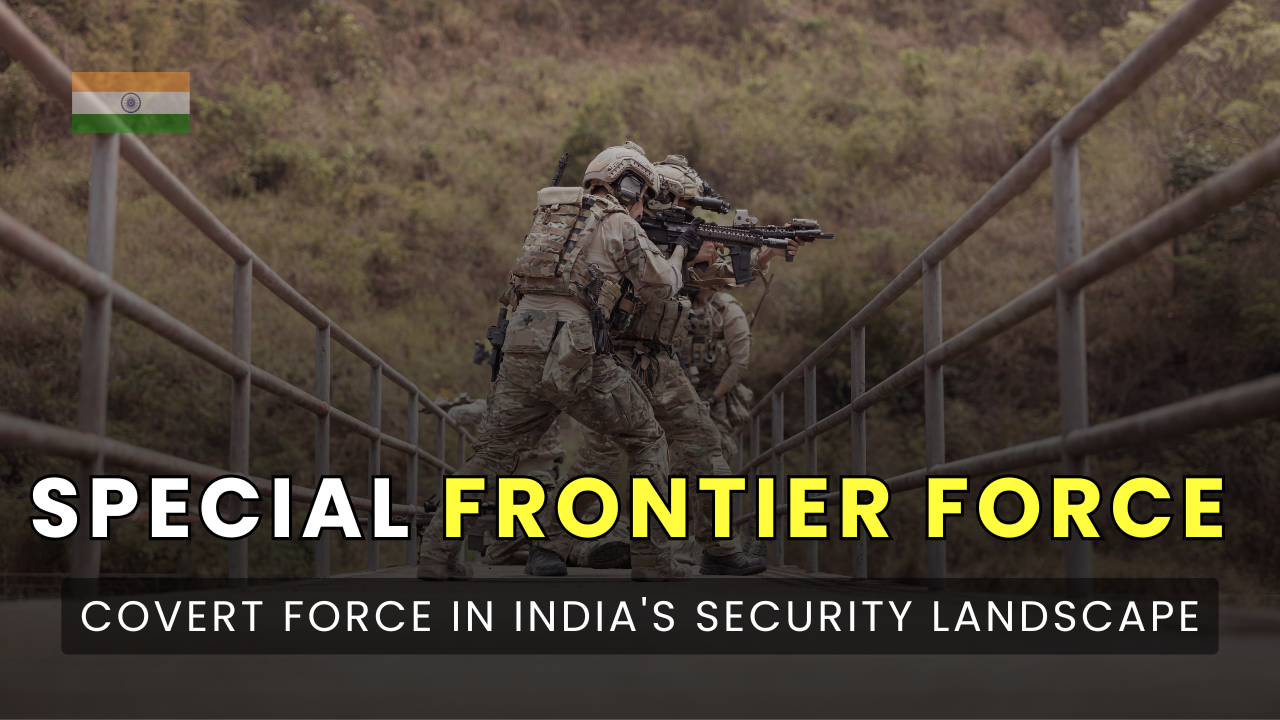The Special Frontier Force (SFF): A Covert Force in India’s Security Landscape
Introduction
The Special Frontier Force (SFF), also known as Establishment 22 or the Vikas Regiment, is one of India’s most secretive paramilitary units. Established in 1962 in the aftermath of the Sino-Indian War, the SFF was initially composed of Tibetan refugees, trained and supported by both the Indian Intelligence Bureau (IB) and the United States’ Central Intelligence Agency (CIA).
Over the decades, the force has evolved from a covert unit designed to counter China to an elite high-altitude warfare force deployed in several conflicts and special operations. Despite its significant contributions, the SFF has largely remained in the shadows, rarely receiving official recognition. This essay explores the origins, training, structure, operations, and evolving role of the SFF within India’s security apparatus, as well as its geopolitical significance and future prospects.
Origins and Formation of the Special Frontier Force
The origins of the SFF lie in the geopolitical tensions of the Cold War era and the consequences of the Chinese invasion of Tibet (1950-1951). Following the failed Tibetan uprising of 1959, the Dalai Lama and thousands of Tibetan refugees fled to India. This event significantly influenced India’s security considerations, especially after its humiliating defeat in the 1962 Sino-Indian War.
As a response to its vulnerabilities along the Himalayan frontier, India sought covert military options to counter China. The idea of raising a Tibetan guerrilla force was discussed among top Indian officials, including B.N. Mullik (Director of the Intelligence Bureau) and Biju Patnaik (then Chief Minister of Orissa).
With covert support from the CIA, the Indian government established the SFF on 14th November 1962. The new force was placed under the direct supervision of the Intelligence Bureau and led by Brigadier Sujan Singh Uban, a former Indian Army officer. The initial recruits were Tibetan exiles, many of whom had previous combat experience as members of Chushi Gangdruk, the Tibetan resistance group that had fought against the Chinese People’s Liberation Army (PLA).
The force was stationed at Chakrata, a remote hill station in Uttarakhand, which became its primary training base. The CIA played a major role in training the force in guerrilla warfare, sabotage, and airborne operations. This collaboration marked a rare instance of US-India military cooperation during the Cold War, although the CIA’s direct involvement diminished after 1972 when US-China relations improved.
Training and Structure of the SFF
The SFF was designed as a highly mobile, guerrilla-style warfare unit that could operate in high-altitude regions and behind enemy lines. Its training and structure were shaped by its unique composition and strategic purpose.
Training: The SFF received specialized training in —
- Parachute jumping and airborne operations
- Guerrilla warfare tactics
- High-altitude combat and survival
- Sabotage and intelligence gathering
- Use of light arms and explosives
Initially, training was conducted with American and Indian instructors, with an emphasis on stealth and unconventional warfare. The recruits were trained in small-unit tactics, allowing them to operate independently in difficult mountainous terrain. Over time, as CIA support declined, the Indian Army took over full control of training.
Organizational Structure: Unlike conventional Indian military units, the SFF operates under the Cabinet Secretariat, reporting directly to the Research and Analysis Wing (R&AW)—India’s external intelligence agency. The force is commanded by an Inspector General, typically an Indian Army Major General. The force is organized into six battalions, known as Vikas Battalions, each specializing in different types of operations. While initially composed entirely of Tibetan exiles, over the years, some Indian Gorkhas have been integrated into the unit to maintain its strength.
Major Operations and Deployments
Despite its original mandate of conducting covert operations inside Tibet, the Special Frontier Force (SFF) has never been deployed for this mission. Instead, it has played a pivotal role in various Indian military operations, often in harsh and extreme conditions. Over the decades, the SFF has adapted to evolving security threats, participating in counter-insurgency, high-altitude warfare, and intelligence operations. From the Bangladesh Liberation War to the Galwan clashes, the force has consistently demonstrated its strategic importance while remaining largely unrecognised in official military records.
The SFF’s first major combat deployment came in the Bangladesh Liberation War of 1971, where over 3,000 Tibetan commandos were secretly sent to the Chittagong Hill Tracts. Tasked with disrupting Pakistani supply lines, the SFF carried out guerrilla raids, demolished key bridges, and engaged in direct combat against Pakistani forces. Despite suffering significant casualties, their actions played a crucial role in weakening enemy defences and ensuring a swift Indian victory. This operation marked the first public recognition of the SFF’s combat capabilities, though its contributions remained largely unacknowledged by the Indian government.
In 1984, the SFF was covertly involved in Operation Bluestar, the controversial military action to remove armed Sikh militants from the Golden Temple in Amritsar. Although the specific role of the SFF remains classified, reports suggest that the force provided intelligence support and possibly engaged in tactical operations. This operation was a sensitive and politically charged mission, and the SFF’s involvement remains a subject of speculation. The lack of official recognition or documentation of their role reflects the continued secrecy surrounding the force’s activities.
The SFF’s high-altitude warfare expertise became evident in its deployment to the Siachen Glacier in 1984, where it has since maintained a permanent presence. Operating in the harshest battlefield conditions in the world, the force has played a vital role in securing India’s strategic positions against Pakistani incursions. In the 1999 Kargil War, SFF units were reportedly involved in covert operations behind enemy lines, aiding the Indian Army’s efforts to retake lost territory. Their contributions in these extreme environments underscore their unparalleled combat skills and importance in India’s military strategy.
The India-China border clashes in Ladakh in 2020 marked a historic moment for the SFF, as it was deployed for the first time against the Chinese PLA. In Operation Snow Leopard, SFF commandos played a key role in capturing strategic heights along the Kailash Range, giving India a tactical advantage in the standoff. The death of Nyima Tenzin, an SFF soldier, brought the force into the public eye, sparking discussions about India’s use of Tibetan soldiers against China. This rare acknowledgement of the SFF’s existence signals a potential shift in India’s approach to recognising the force’s contributions while also sending a strong message to Beijing.
Geopolitical and Strategic Significance
The Special Frontier Force (SFF) occupies a unique position in India’s security landscape, embodying the complex interplay of India-China relations, Tibetan exile politics, and Cold War history. Originally conceived as a covert paramilitary unit, the SFF has evolved into a strategic tool with political, military, and psychological significance. Its very existence serves as a reminder of historical conflicts, unresolved territorial disputes, and India’s shifting defence strategies. While primarily a military asset, the SFF also plays a role in symbolism and diplomacy, reflecting India’s longstanding support for Tibet and its assertiveness in the face of Chinese aggression.
The SFF stands as a symbol of India’s historical support for Tibet, reminding the world of the unresolved Tibet issue and the plight of Tibetan refugees. Since the Dalai Lama’s exile to India in 1959, India has provided shelter and assistance to thousands of Tibetans, many of whom became SFF soldiers. Their recruitment into India’s security apparatus underscores India’s commitment to the Tibetan cause, even as it maintains a cautious diplomatic stance with China. The SFF’s continued existence signals that India has not forgotten Tibet, despite Beijing’s claims of complete control over the region.
Beyond its military role, the SFF functions as a tool of psychological warfare against China. By deploying Tibetan soldiers in border conflicts, India sends a strong symbolic message to Beijing, highlighting its ability to leverage Tibetan nationalism against Chinese interests. This creates a dilemma for China, as it fears Tibetan separatism and unrest within its borders. The presence of Tibetan troops fighting for India is a humiliation for Beijing, challenging its narrative of Tibetan loyalty and subtly reminding the world of the forced occupation of Tibet. This strategic use of Tibetan soldiers enhances India’s negotiating position in its broader engagement with China.
From a military standpoint, the SFF provides India with an elite high-altitude warfare force, specially trained to operate in the harsh Himalayan terrain. The unit’s mountain warfare expertise makes it an invaluable asset in border conflicts, particularly along the Line of Actual Control (LAC) where conventional forces struggle with logistical and environmental challenges. Unlike regular troops, SFF soldiers are seasoned in high-altitude survival, reconnaissance, and rapid mobilisation, making them a crucial component of India’s Himalayan defence strategy. Their participation in the 2020 Ladakh standoff further demonstrated their operational effectiveness in countering Chinese aggression.
Ultimately, the SFF embodies both strategic and symbolic power, making it more than just a military force. It represents India’s evolving China policy, balancing diplomatic caution with covert assertiveness. Whether as a deterrent in border conflicts, a tool of psychological warfare, or a reminder of Tibet’s unresolved status, the SFF remains an important asset in India’s geopolitical toolkit. As tensions with China persist, the SFF’s role is likely to expand, reinforcing India’s preparedness for future Himalayan confrontations while continuing to serve as a powerful emblem of Tibetan resistance.
Challenges and Future Prospects
The Special Frontier Force (SFF) faces several challenges, particularly concerning its identity and future relevance. Many second-generation Tibetan recruits no longer view the SFF as a nationalist movement but rather as a career opportunity, leading to a decline in recruitment. This shift in motivation raises concerns about the force’s long-term viability. Additionally, despite its significant contributions to India’s military operations, the SFF remains largely unrecognised in the country’s military honours system, depriving its personnel of public and institutional acknowledgment. Furthermore, with Tibet’s independence movement losing momentum, the SFF’s original mission has become obsolete, necessitating a strategic reassessment.
Looking ahead, the SFF’s role may evolve in line with India’s security priorities. One possible avenue is its greater integration into counter-insurgency and special operations, where its high-altitude warfare expertise would remain invaluable. Additionally, the recent public exposure of the SFF, particularly during the 2020 Galwan clashes, has prompted calls for greater recognition of its sacrifices. The Indian government may eventually acknowledge the SFF’s contributions more formally, granting it a higher status within the military. Such changes could enhance recruitment, boost morale, and ensure the force’s continued strategic importance.
Conclusion
The Special Frontier Force remains one of India’s most unique and covert military units, with a rich history of covert operations, high-altitude warfare, and intelligence gathering. Though originally intended to liberate Tibet, its role has evolved into protecting India’s strategic interests in the Himalayas. As India-China tensions persist, the SFF’s future will likely remain tied to India’s broader security strategy along the Himalayan frontier.
Subscribe to our Youtube Channel for more Valuable Content – TheStudyias
Download the App to Subscribe to our Courses – Thestudyias
The Source’s Authority and Ownership of the Article is Claimed By THE STUDY IAS BY MANIKANT SINGH



